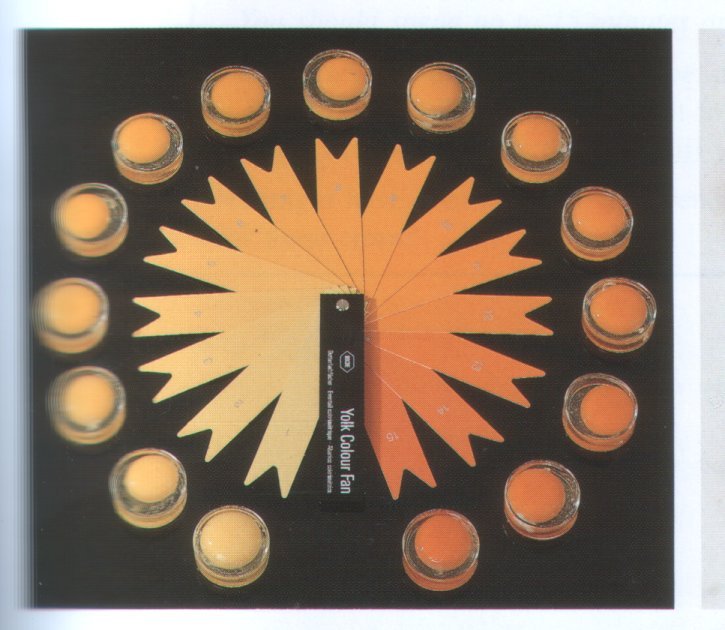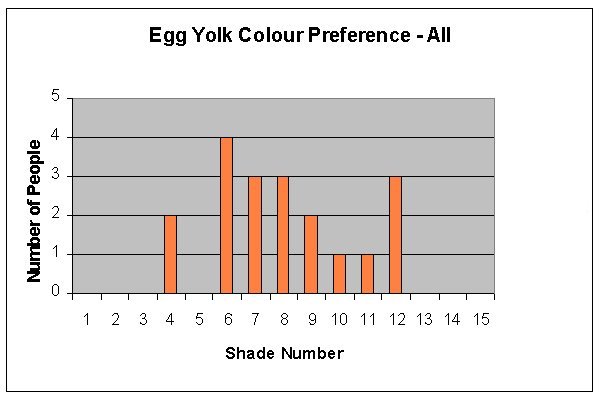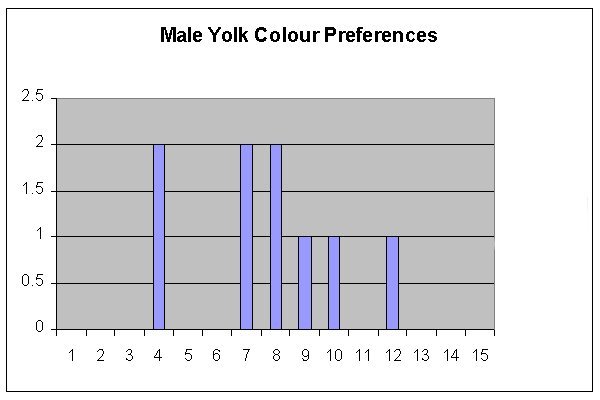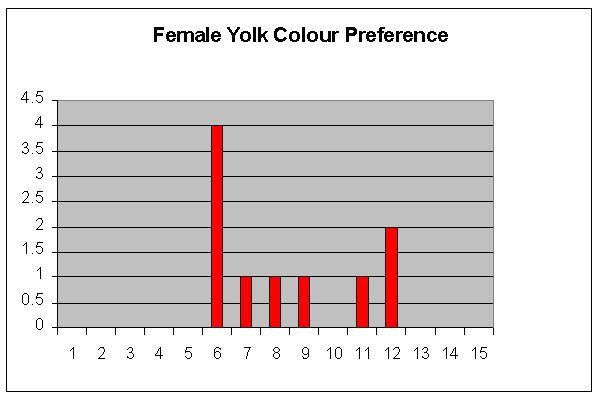S280 Science Matters
Egg Yolk Colour Survey Results (from ex-S103ers conference)

Here are the results of the S103 (and Frances’s immediate family) jury on egg yolk colour preferences - total number of participants: 19. 9 male; 10 female.

This is not exactly what you might call a “normal distribution“, but it does show that nobody much cared for either the very pale eggs or the very dark. While nobody chose number 5, it can be seen from the chart, that more than half of those questioned chose shades 6, 7 and 8 - shade number 6 being the slight favourite - on the lighter side of middle!
Splitting into males and females:


We can clearly see (I think) that, on the whole, women preferred a slightly lighter shade of egg yolk to men.
So, what does all this tell us? Not a lot really!! It tells us, actually, what we expected to find - that is, a middle-of-the-range preference in egg yolk colour - not too dark and not too pale. Comments made during the survey tell us the reason for this - that is that, amongst egg consumers, there are two areas of concern:
(1) Wholesomeness. Does this yolk colour look healthy? Is it full of goodness?
This appeal of “wholesomeness” was tempered with a cautionary “does it have additives”, explaining why the darker coloured yolks were viewed with not a little suspicion.
(2) Happy hens. It was largely considered that a nice, golden egg yolk was indicative of a hen which had led (or was leading!) a happy, free-range life.
This is one explanation for why the pale egg yolks were discarded, as they were considered to be the product of sad hens, locked and squashed up together for endless days, in unhygienic conditions, eating pale, non-nutritious food! The other explanation for the dislike of the pale eggs, being simply that they are “wishy-washy” and therefore unappealing.
A key word here is “organoleptic”, meaning of the sensations such as smell and taste of food. It’s a key word here, as it doesn’t apply! The colour of egg yolks makes no difference to these sensations. Perhaps free-range eggs *do* taste better (I would agree), but, free-range eggs are not necessarily golden in colour (see later) and, in general, the taste of an egg is not down to its yolk colour. It is purely the perception that a golden egg is more nutritious/from happy hen/nicer looking as it runs across the plate/on the dipped soldier, which is the issue in consumers’ preference for a golden egg yolk.
But is a golden egg more wholesome? Has it come from a happy hen? Are there additives? If so, are these additives natural or are they “chemical”?
As we’ve heard already, from Bev and Kev - yes, additives do alter the colour of egg yolks. (For instance, hens fed a diet of maggots will sometimes produce crimson yolks!). And here is the dilemma for consumers, food retailers and poultry farmers alike. There is an optimum yolk colour preference amongst egg consumers - but to achieve a consistent optimum yolk colour in a mass retail situation, synthetic additives must be added to the poultry food. These synthetic compounds are identical to naturally occurring pigmenting agents and produce highly predictable yolk colours. But consumers don’t like synthetic additives, do they? Consequently, poultry are now more often fed naturally occurring pigmenting agents, such as marigold and paprika - but these are produce far less predictable yolk colours than do synthetic compounds!
So, in conclusion, you cannot judge a negg by its colour! If you have a nice, golden egg on your plate, one which meets your desired optimum, unless you know that the egg has come from Bev’s corn-fed chucks, how do you know if that yolk is from a hen which has been happily roaming the fields, yumping up marigolds and worms - or if it’s from a battery-hen, which has been fed the marigolds as an additive to its food? And if it is a battery-hen, has it *actually* been fed marigolds (or other natural agents) - or has it been fed synthetic compounds? Same applies to free-range hens, as they too have additives added to their feed. By the same token, if you have a wishy-washy egg on your plate - it could either be from a battery-hen which is being fed on food which contains natural agents (as these are unpredictable) or it could, equally, be from a free-range, happy hen - in fact, this is probably more likely! What you can be certain on, however, is that a wishy-washy yolked egg hasn’t come from a hen fed on laboratory produced compound additives!
THANK YOU TO ALL PARTICIPANTS (and, indeed, readers - if you got this far!! *yawn*!). This has been an exercise in quantitative science, which could not have been done without your help! :)
(Now I must go and read what my answer should’ve said!!)
824 words!!
Back to S280